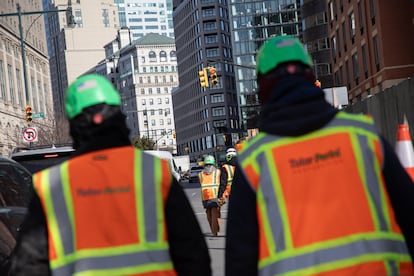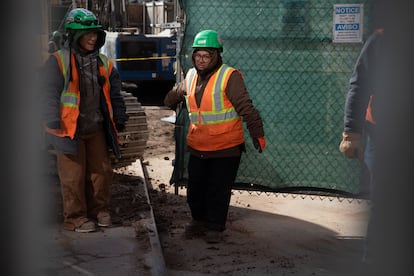A day without immigrants in the United States
Nearly 30 million foreigners work in the country, 20% of the entire working population. Together, with or without permits, they support key sectors of the national economy. If one day they were not there, as Donald Trump envisions, the consequences would be devastating


On February 3, an immigrant strike took place across the United States: numerous businesses closed, children stayed home from school, and workers didn’t show up for their jobs. The protest was a response to the Donald Trump administration, which, in less than three weeks in office, has focused on attacking, criminalizing, and terrorizing the immigrant community with an onslaught of hostile policies. The protest went viral, leading organizers to call for another strike on March 3, with the possibility of continued protests every month. The goal is for all immigrants in the country — more than 47.8 million — to stay home for a day to demonstrate what life would be like without them.
If the president were to achieve his goal, there would be no immigrants in the United States: all those who entered the country illegally would be deported, and the legal protections of those who had successfully regularized their status would be revoked.
But if all the country’s immigrants were to disappear, the economic consequences would be devastating. The United States is a nation built by immigrants. As of 2023, nearly a fifth of the workforce was foreign-born: of the 160.2 million employees, approximately 29.7 million were immigrants, according to the Census Bureau. This figure includes all workers born outside the U.S., including naturalized citizens, permanent residents, refugees, asylum seekers, and the undocumented. In 2022, there were 8.3 million undocumented workers — nearly 5% of the total workforce in that year, according to the Pew Research Center.
Together, with or without legal status, immigrants work across all industries, supporting key sectors like professional and business services, where they make up 4.7 million employees, and manufacturing, where they account for 20.2% of the total workforce. They contribute billions of dollars to the U.S. economy, and if they were to vanish, as Trump envisions, the nation would come to a standstill.
Let’s imagine that scenario.
Who takes care of your baby?
Carolina doesn’t want to “sound tragic,” but if all the immigrants in the country were to disappear, the newborns she cares for would have no one to look after them. The 33-year-old Colombian is a neonatal care specialist who offers her services to parents across the country. With three- to six-month contracts, she lives with the families who hire her and takes care of their babies from 12 to 24 hours a day. She does everything: “I wake them up, change them, feed them, or bathe them,” she says by phone from Vermont, where she’s currently employed.
Carolina arrived in the U.S. in 2017 and became a citizen after marrying an American. However, if the Trump administration were to revoke her citizenship — which wouldn’t be surprising, given the president’s attempts to end birthright citizenship — the families she works with would be devastated. “My absence would have a huge impact. It would be felt in everything: in their daily lives, emotionally, psychologically, and financially. They trust me and know their babies are going to be okay in my care,” she explains.
In 2023, there were 5.5 million immigrants like Carolina working in the education, healthcare, and social assistance sector, according to Census Bureau data. This sector, which contributes $2.3 trillion to the national GDP annually, employs the largest number of foreign-born workers in the country. In fact, 18.4% of all immigrant employees in the U.S. work in this field, which also includes teachers like Andy and Julia.

Classrooms left empty
Andy is a math teacher at a high school in Queens, New York. But the 33-year-old Ecuadorian, who immigrated to the United States with his parents when he was just seven, is much more than a teacher. “I’m one of the first faces that students see when they arrive at school, and by looking at them, I can tell if something’s wrong. If that’s the case, I’m the person who asks if they want to talk about it or if they need any help,” he says. In a school where 90% of the students are Hispanic, if immigrants were to suddenly disappear, not only would Andy be gone, but his school would be left in shambles.
He has already obtained his citizenship, but Julia, also a teacher, is just beginning the long journey toward it. The 26-year-old Cuban, who prefers to keep her real name private, arrived in the U.S. just 10 months ago through the humanitarian parole program. Those who benefit from this status enter the country legally, with two years of stay and a work permit. In Julia’s case, being a Cuban immigrant, after one year in the country, she can apply for permanent residence and, eventually, citizenship. But for Julia, that future is uncertain: the Trump administration has indicated that it is seeking a way to remove legal protections from migrants who entered the country under parole.

That is the reality Julia faces every day when she wakes up and heads to work as a teaching assistant at an elementary school in a small town in eastern Texas, near the Louisiana border. It is the only bilingual school in the area, which Julia describes as “very Republican” and “very conservative.” “At the school, there are four teachers of Latino origin. We’re basically the bridge between the students and the families who don’t yet speak English and the rest of the teachers,” she explains by phone.
“In a context like the one we’re living in, having teachers of Hispanic origin is crucial for children who are integrating into society,” says the Cuban. “So they don’t feel alone and can assimilate. For example, of my 14 students, only a third are American. The rest are Latino, and four of them have only been in the United States for about six months,” she adds. In a hypothetical day without immigrants, Julia’s school, like Andy’s, would not only lack teachers but also students.
The light would go out, and no one would be there to turn it back on
The second-largest sector in the U.S. with the most foreign-born workers — 4.7 million in 2023 — is professional, business, administrative, waste management, and remediation services. This sector is a powerhouse in the U.S. economy, contributing $3.5 trillion annually, or 13% of the nation’s GDP. On a day without immigrants, this sector would lose 22.9% of its employees. Trash would pile up on the streets, businesses would grind to a halt without their administrative teams, and any power outage could lead to widespread blackouts due to a shortage of electricians.
Construction is paralyzed
Ulani and Janet’s voices rise above the noise of construction. “Come on, let’s go!” Ulani shouts. Alongside Janet, the 22-year-old from Puerto Rico directs trucks in and out of a massive construction site in Brooklyn, where a new city-block-sized jail is being built. The women work as flaggers, responsible for controlling traffic, managing material deliveries, and ensuring the safety of workers, pedestrians, and drivers.
“If we weren’t here for one day, everything would stop,” says Ulani on a chilly February morning, when temperatures never rise above freezing. “In fact, I was sick last week, and it was a mess for the team. We all play a role, we all work together, but as soon as one person is missing, the whole chain collapses,” she adds. Ulani and Janet, a 35-year-old Mexican, work 13-hour days, starting at 7 a.m., almost every day of the week. Their team “needs” and “depends” on them, says Janet.

By 2023, 29% of all workers employed in construction were immigrants, with nearly 3.3 million foreign-born workers, making this sector the one with the highest proportion of immigrant labor. At this Brooklyn worksite, however, they make up 50% to 60% of the crew, according to one of Ulani and Janet’s foremen, who is also a migrant. If he, Ulani, Janet, and all the other foreign workers were to disappear overnight, the construction site would collapse, just like many others.
But it’s not just about the tasks left undone if they weren’t there. Their coworkers would also suffer. “Those of us who work here have created a bond of brotherhood between us all. If I weren’t here one day, they would miss me,” says Janet. And their families would be left without support. “I have three children, ages 3, 11, and 14. I have a husband, my mother, and my brothers here. We all depend on the salary we earn to stay afloat,” adds the Mexican. Janet arrived in the United States in 2016 to request asylum and now holds a visa that allows her to work legally.

Manufacturing chain falls into chaos
If immigrants were to disappear for a day, 6.2 million workers would be missing in manufacturing and retail trade. Factories would lose 20.2% of their workforce, stores would be short 15.5%, and hundreds of thousands of families would have no way to make ends meet. In an industry like manufacturing, which contributes $2.65 trillion to the U.S. economy (or 10.3% of national GDP), the economic impact would be immense.
No coffee or lunch served today
It’s almost 11 a.m., and the morning rush should be over, but Jessica doesn’t stop. She can’t: the Venezuelan waitress is the only one working in this small but well-located café where the flow of customers never stops. The café is in Downtown Brooklyn, just a few stops away from Manhattan. Only three people work at the establishment: two men in the kitchen and Jessica in front. “If we weren’t here, the restaurant wouldn’t open. Not only because all of us are Hispanic immigrants, but because the owner himself is too,” Jessica says while serving coffee and taking orders.
Jessica, 41, migrated to the U.S. from Caracas 15 years ago. For five of those years, she was in the country illegally. She now has her papers in order — “thank God” — and has been working in this restaurant for eight years. If she couldn’t work one day, she says she would be “harmed.” “And so would our families. We come here and live day to day. It is difficult, especially with the economy as it is. Almost no one has money saved and the little we had has been running out,” she says.
Octavio, 49, who works in the kitchen, is also Venezuelan. He adds that migrants come to the United States to work. “That is why this country is successful,” he says. Octavio arrived 22 years ago, and for half of that time, he was undocumented.

Like Jessica and Octavio, by 2023, three million migrants were working in the leisure and hospitality sector, making up 10.5% of all migrants in the country. That year, they represented 21% of all employees in this industry. Without them, restaurants across the country would be left without waiters, cooks, delivery drivers, dishwashers...
And who harvests the crops?
There is a common misconception that most immigrants in the United States work in agriculture, tilling the soil and harvesting crops. But in reality, fewer than 500,000 immigrants are employed in agriculture, forestry, fishing, and hunting sectors, according to official data from 2023 — although some organizations suggest the number is actually much higher.
But immigrants make up a significant portion of this workforce: at least 20% of workers in the agricultural industry were born outside the U.S., according to the Census Bureau. Some organizations, like Farmworker Justice, place that percentage even higher, at 68%, based on their findings. In their National Farmworker Survey in 2020, the organization reported that 44% of these workers were undocumented — a figure they believe is likely an undercount. That’s why, when the administration attempts mass raids, the fields empty, and workers feel the weight of fear.
Sign up for our weekly newsletter to get more English-language news coverage from EL PAÍS USA Edition
Tu suscripción se está usando en otro dispositivo
¿Quieres añadir otro usuario a tu suscripción?
Si continúas leyendo en este dispositivo, no se podrá leer en el otro.
FlechaTu suscripción se está usando en otro dispositivo y solo puedes acceder a EL PAÍS desde un dispositivo a la vez.
Si quieres compartir tu cuenta, cambia tu suscripción a la modalidad Premium, así podrás añadir otro usuario. Cada uno accederá con su propia cuenta de email, lo que os permitirá personalizar vuestra experiencia en EL PAÍS.
¿Tienes una suscripción de empresa? Accede aquí para contratar más cuentas.
En el caso de no saber quién está usando tu cuenta, te recomendamos cambiar tu contraseña aquí.
Si decides continuar compartiendo tu cuenta, este mensaje se mostrará en tu dispositivo y en el de la otra persona que está usando tu cuenta de forma indefinida, afectando a tu experiencia de lectura. Puedes consultar aquí los términos y condiciones de la suscripción digital.
More information
Archived In
Últimas noticias
Russell Tovey: ‘I was advised many times not to come out, I don’t think there was many people who’d done that — and I feel really proud that I’m one of those that did’
Merz tries to replace Macron at the helm of Europe
Indulgence, punishment and family dynamics: Maintaining a healthy relationship with food during the holiday season
Patagonia’s puma population soars thanks to unexpected prey: penguins
Most viewed
- The low-cost creative revolution: How technology is making art accessible to everyone
- Families demand repatriation of bodies of Colombians who died in Ukraine: ‘This war is a slaughterhouse for foreigners’
- Christian Louboutin: ‘Young people don’t want to be like their parents. And if their parents wear sneakers, they’re going to look for something else’
- US sanctions against jailed cartel leader ‘El Marro’ highlight Mexico’s lack of control over its prisons
- Liset Menéndez de la Prida, neuroscientist: ‘It’s not normal to constantly seek pleasure; it’s important to be bored, to be calm’










































